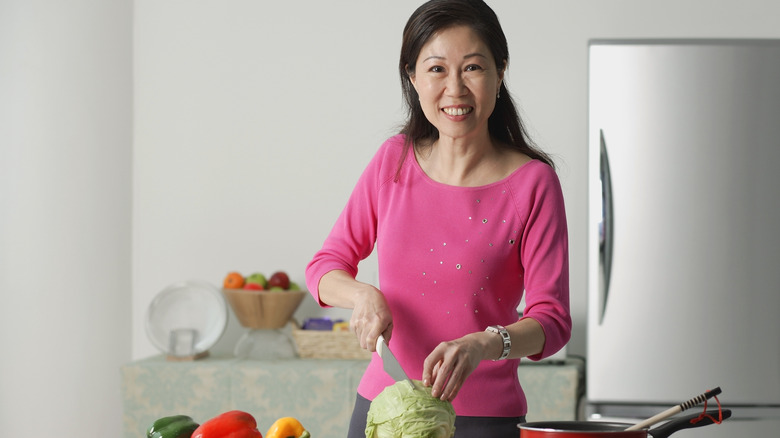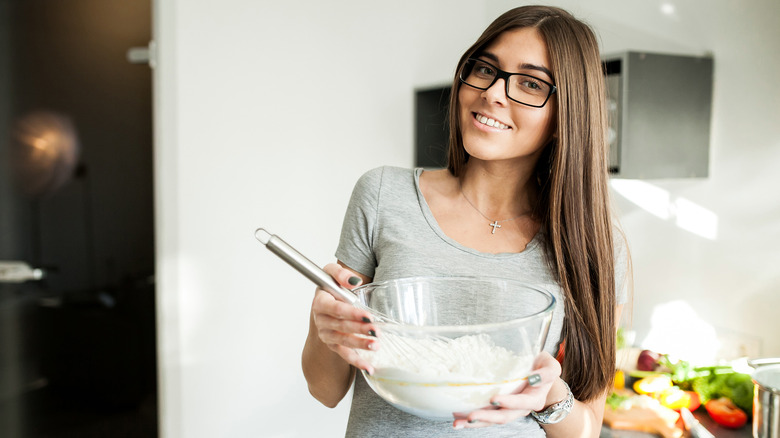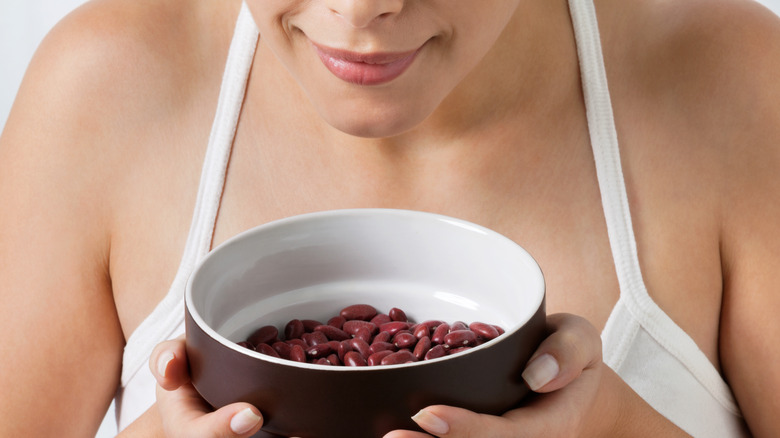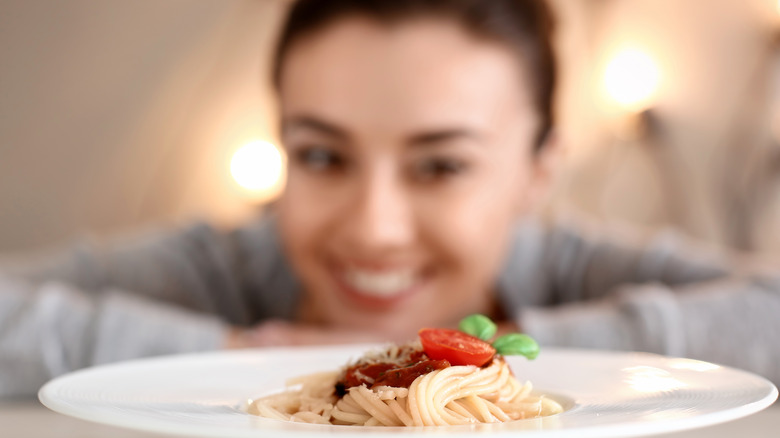Easy Ways To Sub Healthy Food Into Your Diet
Trying to maintain a healthy diet is one of the most vexing issues we face in modern life. Highly processed, unhealthy foods are not only widely available, but are often the only option presented in schools, offices, hospitals, gas stations, and, well, just about everywhere other than the grocery store. Adding to which, most people are seriously pressed for time, and it's hard to find the bandwidth needed to research what to eat instead of all those ubiquitous, often yummy, but equally often unhealthy foods.
Knowing how big of a challenge this can be, what's a gal to do? Well, don't worry: We have your back! We dug deep into the available research and spoke to some experts to figure out some hacks and substitutions that will help you navigate the confusing world of modern food. Hopefully, these will help make healthy options a bit more manageable, accessible, and doable!
Use these oil substitutes when baking
Baked goods are the holy grail for almost everyone, but particularly for people who are trying to watch their calorie intake. Instead of eliminating baked goods altogether — which would be sad, and really, no one needs that — you can make key substitutions that help turn a baked treat into something actually good for you.
The Mayo Clinic recommends using half of the butter or oil in a recipe, and replacing the other half with applesauce or prune, pear, or banana puree. This not only helps cut down on fat, it also adds fiber and other beneficial nutrients found in fruit. As Better Homes and Gardens notes, cup-for-cup, substituting pear puree adds nine grams of fiber (compared to zero in oil) and will decrease the calorie and fat count of whatever you're baking.
Charlotte Furman, Registered Dietician and Clinical Director of the University of Washington Medical Center's Department of Food and Nutrition, noted in an interview for the school's holistic wellness newsletter that when replacing fats with fruit puree, "a good rule of thumb is to replace half the fat." Fat has important roles in the baking process, and if you replace all the fat in a recipe, the end product will change substantially. However, because pureed fruits contain pectin (a fiber found in fruit that acts as a stabilizer and tenderizer), they can easily replace 50% of the oil.
Use these flour substitutes for more baking hacks
As the Mayo Clinic further notes, you can also find ways to substitute half of the flour in most recipes. For example, if a recipe requires two cups of all-purpose flour, by replacing one of those cups with whole wheat flour, you can add more good-for-you fiber to the mix. However, if wheat and gluten aren't your jam, there are plenty of gluten-free flours that can be substituted as well.
According to Jamie Logie, a nutritionist, health coach, and personal trainer, almond and coconut flours are great bets in place of wheat flour. Wheat flours are considered to have a higher glycemic index, he told The List, and can cause blood sugar to quickly rise and fall. By sticking with almond and coconut flour, you not only get a good dose of protein, but you avoid the dreaded blood sugar peaks and valleys.
Sai Aparajitha Khanna, a health and wellness coach in the United Kingdom, explained that she recommends using cacao powder in place of flour. Naturally gluten-free, "[n]ot only does it lower the carb content of the dishes, high-quality cacao also makes dishes so much more chocolatey," she told The List. It also packs an impressive nutritional punch. With 4000 times as much magnesium as wheat flour, cacao powder also contains more iron and calcium than its glutinous counterpart. More nutrients and more chocolate flavor? Sign. Us. Up.
Bring out the flavor of your dishes without excess salt
As we all know, salt is the standard go-to ingredient when it's time to jazz up a dish — but as Web MD notes, too much sodium can contribute to health conditions like high blood pressure, which can lead to cardiovascular and kidney diseases. The same goes for sugar, since all know that added sugars aren't a great idea — and according to the Harvard School of Public Health, they contribute to health conditions like type 2 diabetes, obesity, and heart disease.
How can you add flavor to a dish without pouring on the salt or the sugar? This is where your friendly local spice rack can save the day: Adding, or even doubling, the spices in any dish can help kick it up a notch. For example, according to the Mayo Clinic, extra cinnamon in a recipe helps enhance the sweetness on your tongue, which makes it possible to reduce the amount of sugar you use.
In fact, National Institutes of Health offers this handy sheet, and the Cleveland Clinic has this list, to help you determine which spices to use in place of salt and sugar. Which spices are best will depend on the dish — sweet or savory, light or hardy, veggies or meat — but rest assured: Just like there's a lid for every pot, there's a spice for every food.
Embrace these egg replacements
Flax and chia seeds are borderline miraculous, packing a lot of nutritional power into something so tiny. According to Becky Kerkenbush, a registered dietitian in Watertown, Wisconsin, flax and chia seeds are "both high in soluble fiber and omega-3 fatty acids, plus [they] contain protein and are gluten-free." Both can be used as an egg substitute: Use one tablespoon ground flax or chia seed, add three tablespoons of water, wait a moment for it to congeal, and voila! An egg substitute that Kerkenbush describes as "suitable for vegans, those allergic to eggs, or those trying to reduce fat and cholesterol from their diet."
She recommends purchasing whole seeds and then grinding them when you're ready to use them, since this — plus storing them in the fridge — will keep their natural oils from going rancid.
For those who can tolerate soy, tofu can be impressively versatile. One option is to make a tofu scramble instead of scrambled eggs. Kerkenbush also told The List that silken tofu is a serious pinch hitter as it can be used to make sauces and soups creamier, in place of cream cheese in cheesecakes and pies, and to thicken up smoothies and puddings.
Rely on these genius subs for sour cream and mayo
Who doesn't love a baked potato loaded with sour cream? However, if you're looking for a healthier choice, go for Greek yogurt instead. Juliana Shalek, a registered dietitian in New York City, told The List that she recommends using Greek yogurt in place of sour cream, alfredo sauce, or other cream sauces. "It has a creamy texture/consistency but is low in fat and high in protein, making it an all-around healthier ingredient to use," she said.
Shaleck and Kerkenbush both also recommend using avocados in place of mayonnaise. "Avocado gives a creamy consistency like mayo, but with much more nutritional value," noted Shalek. Kerkenbush added that by doing this, you can reduce your intake of unhealthy fats and cholesterol, and also get a good dose of healthy mono- and poly-unsaturated fats.
What makes avocados such a great substitute? Lori Zanini, a dietitian based in California and the spokesperson for the Academy of Nutrition and Dietetics, explained to SELF magazine that "including healthy fats in our meals during our day is important in order to keep us full and satisfied after meals, since fats take longer to digest than carbohydrates or proteins.... additionally, avocados are naturally sodium and cholesterol free," she said. Also, according to Web MD, avocados are a nutritional powerhouse: With over 20 vitamins and minerals including vitamins C, K, E, potassium, and lutein, they're a sure nutritional bet.
Swap out red meat in favor of these proteins
One of the best swaps you can make? Instead of eating red meat, swap it out in favor of lean poultry or plant-based protein sources like beans, legumes, nuts, tofu or tempeh. Red meat, while acceptable in moderation, is linked to conditions such as colorectal cancer and heart disease — and, according to the Harvard School of Public Health, premature mortality. None of which sound like fun.
Instead, the experts at Harvard recommend following a Mediterranean-type diet, which relies heavily on a daily intake of fruits, veggies, whole unrefined grains, beans, legumes, nuts, and seeds, with minimal consumption of red meat. If beans aren't your thing, you can also replace red meat with fish or lean poultry. In fact, according to a study published in The British Journal of Nutrition, replacing red meat with fish or poultry was associated with a lower risk of heart attack. So, while you don't have to give up steak entirely, frequently swapping it out in favor of other protein sources will do your body good: Your heart, and your GI tract, will thank you.
Look to these alternative types of pasta
Pasta lovers, unite! For those of us who can't imagine life without it, there are some excellent substitutions that can help make a giant bowl of spaghetti healthier. According to the Mayo Clinic, substituting whole wheat pasta in place of enriched pasta will provide almost three times the fiber. And, as we all know, fiber is one of your body's best friends: The Mayo Clinic also notes that, while fiber is "best known for its ability to relieve constipation... it can provide other health benefits as well, such as helping to maintain a healthy weight and lowering your risk of diabetes and heart disease."
For those of us who can't eat wheat, Melissa Eboli, a certified nutritional chef, told The List that using pastas made with lentils, kale, or black beans can make a world of difference. "Grain-free pasta is preferable to regular pasta for a number of reasons," she explained. In addition to having more protein than traditional pasta options, she noted that the grain-free varieties tend to cause fewer problems with bloating, inflammation, and indigestion.
Embrace these dairy-free alternatives
For some, giving up dairy altogether is an important step to both feeling better and being healthier. Luckily, if you're looking to cut back on or eliminate dairy, there's a veritable cornucopia of healthy swaps you can make.
As Reader's Digest notes, butter can be swapped out in favor of olive oil, nutritional yeast can replace cheese, and non-dairy milks and yogurts are excellent substitutions for the traditional versions. Rebecca Lewis, the in-house dietician at Hello Fresh, told Reader's Digest that nutritional yeast, which is dairy-free and gluten-free, has "a savory cheese flavor," — and since it's usually fortified with vitamin B12, that's an added bonus for vegans and vegetarians.
Furthermore, Lewis explained that "soy, almond, and coconut milk/yogurt are now a staple in most grocery stores and still contain those gut-loving probiotics we love." With fewer calories and less sugar, fat, and sodium than dairy, Lewis noted that "these nut-based milks are better for your waist-line as well."
Another dairy-free hack is to replace the milk in a smoothie with coconut milk — or even coconut water. According to the Recipes for Health column in The New York Times, coconut milk can help thicken up a smoothie in place of milk or yogurt, and it adds the benefit of healthy fats without the potential indigestion. Drink up!
Implement these genius snack swaps
For many of us, snacks can be our Achilles heel: To say the least, unhealthy snacks are abundant and often the most convenient option. Happily, though, healthy snack swaps do exist. Web MD, along with numerous nutritional experts, recommend looking to fresh fruits and veggies, home-made popcorn, and condiments like nut butters, hummus. In an interview with Web MD, registered dietitian Dr. Elaine Magee recommends low-fat, whole-grain crackers with low-fat cheese, and fruit smoothies.
For other options, Jamie Logie, a nutritionist and personal trainer based in London, Ontario, recommends making stovetop popcorn. "Microwave popcorn is really unhealthy," he said, so he recommends keeping popcorn kernels on-hand and "pop them on the stovetop with a bit of olive oil." If you sprinkle it with sea salt and parmesan for flavor, he said, you'll get magnesium, B vitamins, "a ton of antioxidants and some healthy fats from the olive oil, and trace minerals from the sea salt" while avoiding the chemicals, trans fats, and additives that come from microwave bags.
Logie also recommends keeping easily-transportable, nonperishable foods on hand, like raw almonds or walnuts, that can be easily combined with fresh fruit for a satisfying, healthy snack. "These foods contain all the things that will help fill you up and keep you full while providing good nutrition, specifically fiber, protein, healthy fats, and water," he explained. Nuts and fruit FTW!
Put these in everything
Perhaps the most helpful hack? Put veggies in everything.
For example, Mobile, Alabama based nutritionist Erin Akey recommends swapping out regular rice, and using riced cauliflower in its place. "An entire head of cauliflower has 146 calories and about 15 grams of carbohydrates," she explained, and is "loaded with vitamin C, calcium, and vitamin B6." Meanwhile, she said, rice doesn't carry the same nutritional punch for its caloric tradeoff. Part of cauliflower's appeal, she added, is that it's a culinary blank canvas, and "it takes on the taste of whatever you cook with."
Akey also recommends that clients use raw veggies instead of pita chips when dipping into hummus. "Hummus is an incredibly healthy snack, but many people [make it unhealthy] by using pita chips, which have no nutritional value," she explained. Instead, she prefers veggies like raw bell peppers, carrots, broccoli, or cucumbers. These provide vitamins, fiber, and nutrients, but without the extra calories, sugars, and oils in pita chips.
Additionally, New York-based nutrition and wellness coach Tami Racaniello recommends a "strive for five" policy on veggies. It's "super easy to add peppers, onions, mushrooms, spinach, and broccoli to an omelet or slice of pizza," she explained. She also said that stir-fry recipes and pasta dishes can also be great places to add extra veggies, and that the "strive for five" approach helps people be more aware of their veggie intake. Bottom line: The more vegetables you can incorporate into your daily life, the better!










